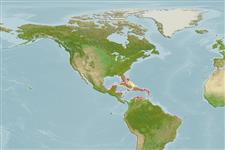Common names from other countries
Environment: milieu / climate zone / depth range / distribution range
Écologie
; profondeur 0 - 2 m (Ref. 2022). Tropical
Distribution
Pays | Zones FAO | Écosystèmes | Occurrences | Introductions
Western Central Atlantic: USA, Colombia and the West Indies.
Length at first maturity / Taille / Poids / Âge
Maturity: Lm ? range ? - ? cm Max length : 3.8 cm TL mâle / non sexé; (Ref. 281)
Description synthétique
Morphologie
Maximum Total Length: 3.8 centimeters. Body: Elongated; has girdle that covers most of the valves. Valves: Have four clumps of long, glassy bristles near the anterior valve and one on each side of the other valves. Clumps: Set in cuplike collars of the girdle. Pustules: Tiny, round, sharply raised; covering end valves and lateral areas of middle valves. Dorsal longitudinal ridge: Raised, narrow, distinct and smoothish except for very fine pinpoints. Lower edge of the girdle: Dense fringe of brown or bluish bristles (Ref. 281).
Upper sublittoral, under stones and coral rubble (Ref. 2022, page 123).
Life cycle and mating behavior
Maturité | Reproduction | Frai | Œufs | Fécondité | Larves
Members of the class Polyplacophora are mostly gonochoric. Life cycle: Eggs hatch into lecitotrophic planktonic trocophore larvae (no veliger stage) which later metamorphose and settle on the bottom as young adults.
Burghardt, G. and L. Burghardt. 2006. (Ref. 281)
Statut dans la liste rouge de l'IUCN (Ref. 130435)
statut CITES (Ref. 108899)
Not Evaluated
Not Evaluated
Utilisations par l'homme
| FishSource |
Outils
Plus d'informations
Taille/ÂgeCroissanceLongueur-poidsLongueur-longueurMorphologieLarvesAbondance
Sources Internet
Estimates based on models
Preferred temperature
(Ref.
115969): 23.8 - 28.3, mean 27.1 (based on 319 cells).
Vulnérabilité
Low vulnerability (10 of 100).
Catégorie de prix
Unknown.
